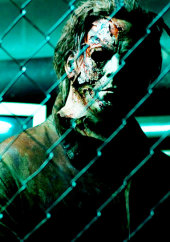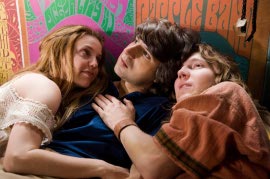 THE FINAL DESTINATION and HALLOWEEN II
THE FINAL DESTINATION and HALLOWEEN II
In a somewhat odd scheduling decision, this past weekend saw the release of both The Final Destination - the fourth in the popular series of cheat-death-and-pay-the-price splatter flicks, presented (on some screens) in eyeball-gouging 3D - and Halloween II, writer/director Rob Zombie's sequel to his 2007 remake of John Carpenter's horror classic. But for fellow genre fans wondering which of the two makes for a more gratifying fright film, I'm afraid it's a draw; the former is kind of fun but mostly terrible, while the latter is kind of fascinating but almost no fun at all.
The latest, potentially last, and easily least of its franchise entries, The Final Destination doesn't deviate one iota from its proven blueprint, in which generic victims-in-waiting narrowly escape a catastrophic tragedy, and wind up being killed anyway through a series of grotesque and comically convoluted "accidents." Yet as someone who's enjoyed all three of the previous Destinations (despite my enjoyment waning a tad with each new entry), I wasn't really bothered by the movie's slavish devotion to formula. The design may be predictable, but it's still reasonably effective, and if I'm going to watch blandly pretty things die for 80 minutes straight, I'd much rather it be through hubris and fate than via some hulking brute with a butcher's knife.
Your first hint, though, that The Final Destination isn't going to be the schadenfreude-rific good time you're hoping for comes relatively early. In what has become as recognizable a cinematic ritual as the pre-credits chase scene in a James Bond picture, the movie's prelude presents us with a deteriorating locale - here, it's a motor speedway in serious need of repair - and a number of potential, seemingly unrelated hazards (a broken stadium seat, an oil spill on the racetrack). Our entertainment stems from the giggly anticipation in watching these warning signs converge, resulting in a veritable mouse trap of carnage. In director David R. Ellis' sequel, however, you're more likely to be giggling derisively; the glaringly phony CGI explosions and cartoonish, in-your-face effects pull you out of the movie at the exact moments you should be wincing - and, in the film's 3D presentation, ducking - in terror.
Given the blandly uncommitted acting by the personality-deprived cast, there was hardly a chance that we'd be emotionally engaged in The Final Destination. But beginning with that opening calamity, what's disappointing is how little we're engaged on any other level; beyond the shoddy visuals, the protracted setups to the subsequent deaths - nearly all of them involving some combination of faulty equipment and an overflow of liquid - are particularly, dishearteningly uninspired. The movie's too lightweight to be embarrassing, and there are some nice comedic touches, as when our nominal hero attempts to rescue his girlfriend from certain death in a cineplex, but doesn't know which of the eight auditoriums she's in, as they're all showing the same movie. Yet there's no getting around the film's lazy, going-through-the-motions vibe. Even with the glasses, it's a depressingly one-dimensional experience.
 Zombie's sequel, meanwhile, is also a pretty tough sit, even though it's a considerable improvement on his crass, brutal, and achingly boring Halloween revamp, and the auteur definitely earns points for eccentricity; any movie that provides roles for Malcolm McDowell, Brad Dourif, Howard Hesseman, Margot Kidder, and "Weird Al" Yankovic can't be completely disregarded.
Zombie's sequel, meanwhile, is also a pretty tough sit, even though it's a considerable improvement on his crass, brutal, and achingly boring Halloween revamp, and the auteur definitely earns points for eccentricity; any movie that provides roles for Malcolm McDowell, Brad Dourif, Howard Hesseman, Margot Kidder, and "Weird Al" Yankovic can't be completely disregarded.
The first half hour is an effective-enough condensation of the original Halloween II, with tortured sibling Laurie Strode (Scout Taylor-Compton, forever in hysterics) evading unkillable brother Michael Myers (Tyler Mane) in a nearly vacant hospital, and Zombie staging the shocks and dread with considerable force and visual acuity. To be sure, this extended prelude is overly grim, and God knows it continually defies logic. (How does this seven-foot-tall bruiser keep sneaking up on people?) But if you heed the clues, Zombie very clearly establishes that the lack of logic is intentional, and his risky, rather witty opening reels culminate in a wonderfully disconcerting aural running gag, in which every television set in the hospital is tuned to the exact same program: a black-and-white, '60s-era performance of the Moody Blues singing "Knights in White Satin." (Damn Zombie - I'll never hear that song in the same way again.)
Ironically, though, once Halloween II diverges from the outline of its inspiration, Zombie's own inspiration seems to dry up, and the next hour-plus degenerates into a shapeless, confounding mélange of questionable pop psychology, borderline-pretentious dream imagery, painfully overwrought performances, and increasingly tired "Boo!" effects. I'd be lying if I said the results weren't frequently intriguing; Zombie's compositions and employment of dank, evocative color schemes suggest that, despite Halloween II's vulgarity, there actually is an artist at work here. But it remains a depressingly unsatisfying horror escapade. At the screening I attended, some back-row patrons began vocalizing their displeasure with greater and greater (and ever-more-irritating) vehemence, with one finally blurting out "This movie sucks!" A guy in the front row responded, "You suck!" Turns out they were both right.
 TAKING WOODSTOCK
TAKING WOODSTOCK
After my back-to-back two-fer of The Final Destination and Halloween II, nothing relieved me more than being able to escape into the friendly, openhearted sweetness of Ang Lee's Taking Woodstock. I'm reasonably sure, though, that I would've felt this way even if I hadn't just endured three hours of near-constant evisceration. Despite the title, there's very little music heard in director Lee's and screenwriter James Schamus' spirit-of-the-'60s collage; the film takes place on the outskirts of the legendary rock festival, and fittingly, Hendrix and Joplin and the Who are left on the outskirts, too. Yet the movie still sings. It's a lovely, graceful examination of a specific American era - one before music felt wholly co-opted by commerce - and like the film's bucolic Catskills setting, it provides an invigorating breath of fresh air.
There's very little in terms of plot, which finds budding entrepreneur Elliot Teichberg (Demetri Martin) arranging to have the Woodstock festival housed on farmland near his parents' shabby motel in White Lake, New York. Preparations are made, the concert is held, and that's pretty much that; anyone hoping for actual insight into Woodstock's genesis had best search elsewhere. And the film's structural looseness and deliberate evasion of narrative are occasionally frustrating. We never get to see how several key characters - particularly Eugene Levy's pragmatic farm-owner - react to the youthful onslaught, and a number of potentially prominent storylines (including a promising one involving Emile Hirsch's haunted Vietnam veteran) are left dangling.
Yet there's so much geniality and goodwill on display that you can easily ride past Taking Woodstock's flaws; it's a soothing comedy that never turns snoozy. Lee's outing is relaxed and beautifully detailed, and while a few portrayals are overbaked - Imelda Staunton's rampaging Jewish mama, with her stockings at mid-calf, comes dangerously close to caricature - the majority of the cast exudes infectious charm: Martin, Levy, Henry Goodman, Dan Fogler, Paul Dano, Kelly Garner, Mamie Gummer, and especially Jonathan Groff (an original star of Broadway's Spring Awakening, making an exceptional screen debut) manage the considerable feat of making amiability seem damn near dynamic. Best of all, perhaps, is Liev Schreiber, who's unfailingly endearing as a former Marine recruited for Woodstock security. I never thought I'd see the famously intense actor as unequivocally likable as he is here, but then again, I never thought I'd see Schreiber onscreen in a light blond wig and form-fitting cotton dress, either.










